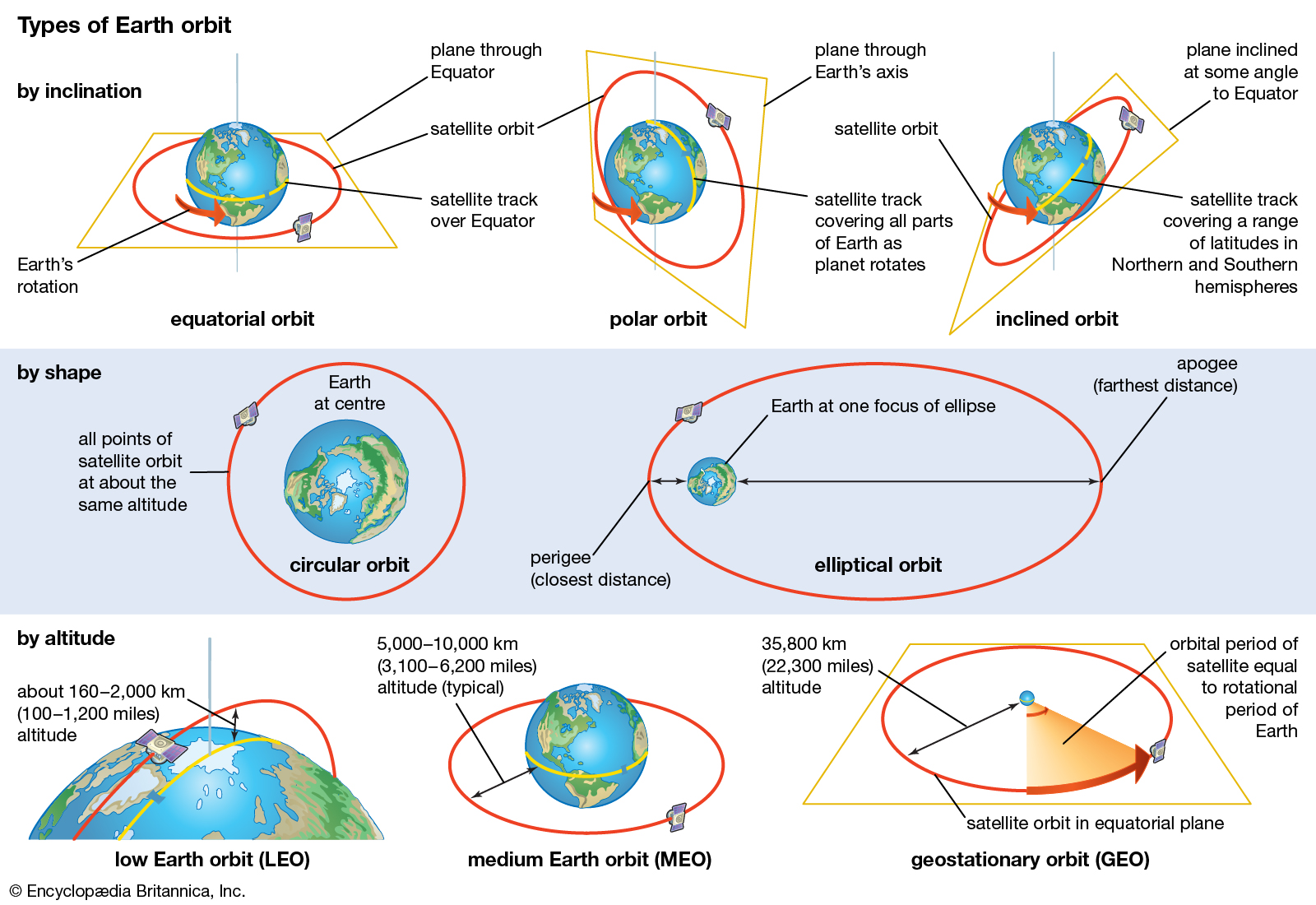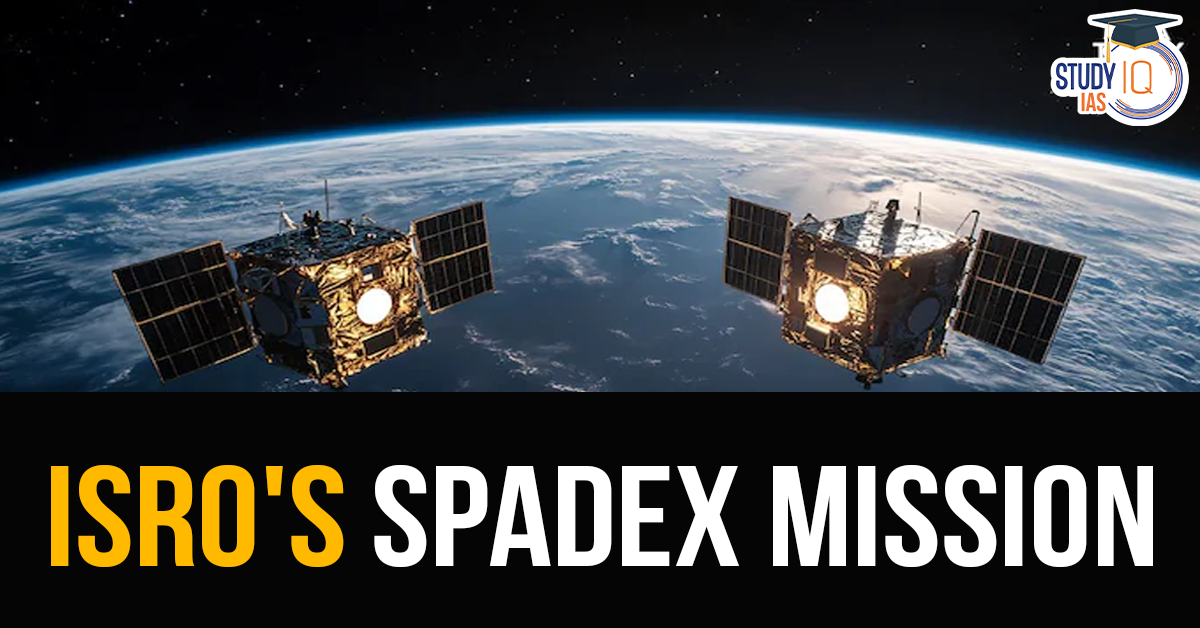Table of Contents
Context: ISRO is set to launch the SPADEX-2 Mission, aiming to dock two satellites in an elliptical orbit. ISRO has successfully undocked its two experimental satellites, SDX01 (Chaser) and SDX02 (Target).
What is the SpaDeX Mission?
The SpaDeX mission is designed to demonstrate in-space docking technology using two small spacecraft, known as SDX01 (Chaser) and SDX02 (Target). These spacecraft were launched into low Earth orbit to showcase the precise manoeuvring required for rendezvous, docking, and undocking in space. This technology will play a crucial role in future missions, particularly for lunar exploration missions like Chandrayaan-4, which will require autonomous docking without relying on Earth-based GNSS (Global Navigation Satellite Systems).
| Facts about the SpaDeX Mission | |
| Full Form | SPADEX stands for Space Docking Experiment. |
| Type | A cost-effective technology demonstrator mission. |
| Objective | To develop and demonstrate the technology for Rendezvous, Docking, and Undocking of two small spacecraft (SDX01 – Chaser, SDX02 – Target) in low-Earth circular orbit. |
| Launch by | PSLV |
PSLV-C60: The Launch Vehicle
The PSLV-C60 is a Polar Satellite Launch Vehicle (PSLV), known for its reliability and versatility. The PSLV rocket, standing 44.5 meters tall, successfully carried the SpaDeX payload into space. Each spacecraft in the mission weighs approximately 220 kg, and the mission is regarded as cost-effective and innovative in terms of space technology.
PSLV-C60 Launch Time and Rescheduling
The launch was initially planned for 9:58 PM IST but was rescheduled to 10:00 PM IST on the same day. Although the exact reason for the rescheduling was not officially confirmed, the launch occurred smoothly, with the PSLV-C60 successfully placing the SpaDeX spacecraft into orbit.
ISRO’s SpaDeX Mission Objectives
- Primary Objective – Docking Manoeuvre: The satellites will demonstrate docking (joining) and undocking (separating) while in orbit.
- Secondary Objective – Electric Power Transfer: Transfer of electric power between docked spacecraft. It is a critical technology for:
- In-space robotics.
- Composite spacecraft control.
- Payload operations post-undocking.
The SpaDEX mission is designed to achieve several critical objectives:
- Demonstrating Docking Technology:
- Precise alignment, approach, and docking of two satellites in orbit.
- Controlled separation post-docking, with continued independent operation.
- Electrical Power Transfer:
- Validating the transfer of electrical power between docked spacecraft, a key capability for future modular missions.
- Microgravity Experiments:
- Utilisation of the PSLV’s fourth stage (POEM-4) as a platform for experiments, including a robotic arm for debris capture and a seed germination study.
- Long-Term Payload Operations:
- Post-separation, the satellites will operate independently for up to two years, conducting research and data collection.
Phases of SpaDeX Mission
Deployment and Far Rendezvous
- The satellites will be deployed simultaneously into orbit with a small relative velocity. Within 24 hours, the distance between them will increase to 10-20 km.
- The propulsion system on the Target satellite will stabilise the separation, ensuring controlled movement at this range.
Progressive Approach
- The Chaser satellite will close the distance in a stepwise manner, achieving relative separations of 5 km, 1.5 km, 500 m, 225 m, 15 m, and finally 3 m.
- Advanced navigation sensors and algorithms will guide the Chaser to approach the Target with precision.
Docking Operations
- Once the satellites are within 3 meters, docking will occur. This includes:
- Precision alignment to ensure no collisions.
- Successful latching of docking mechanisms.
- Demonstration of electrical power transfer and joint operation.
Post-Docking and Separation
- After demonstrating docking and power transfer, the satellites will separate to begin their independent missions.
Technological Innovations
- Docking Mechanism: A state-of-the-art docking interface ensures precise alignment and secure latching.
- Advanced Sensors: Utilises a suite of navigation sensors to prevent collisions and enable smooth docking.
- Orbit Determination Processor: A novel constellation-based navigation system ensures accurate relative orbit determination.
- Microgravity Experimentation: The PSLV’s spent stage will host cutting-edge experiments, such as:
- A robotic arm for debris capture.
- A study to observe plant growth in microgravity.
Importance of SpaDEX Mission
In-space docking is a critical capability for:
- Human missions to the Moon
- Lunar sample return missions
- Construction and operation of the Bharatiya Antariksh Station (BAS) (India’s planned space station)
- Enables coordination of multiple rocket launches for a single mission goal — essential for long-duration or modular space missions.
- With this mission, India aims to become the fourth country in the world to demonstrate space docking technology, after the USA, Russia, and China.
Strategic Importance
- Docking technology is a cornerstone for future space stations and interplanetary missions.
- Enables assembly and servicing of large structures in orbit, such as the proposed Bharatiya Antariksh Station (BAS).
Global Competitiveness
- Positions India as the fourth nation, after the US, Russia, and China, to demonstrate in-space docking.
- Reinforces India’s reputation as a cost-effective innovator in space technology.
Scientific Advancements
- Provides valuable data on vegetation, natural resources, and space radiation.
- Opens doors for collaborations with academic institutions and startups for space-based experiments.
Significance of the Docking and Undocking Experiment – Crucial for future ISRO missions
- Chandrayaan-4: A lunar sample return mission that will require multiple dockings in the Moon and Earth orbit.
- Bharatiya Antariksha Station (Indian Space Station): Planned for 2035, requiring modular assembly in space.
- Human spaceflight missions: Future astronaut missions will require docking for crew and cargo transfer.
Bharatiya Docking System (ISRO’s Indigenous Docking Mechanism)
- ISRO developed its own Bharatiya Docking System for the experiment.
- It is similar to the International Docking System Standard (IDSS) but has key differences:
- Androgynous system: Both Chaser and Target satellites have identical docking mechanisms.
- Simplified design:
- IDSS uses 24 motors for docking.
- ISRO’s system achieves docking with only 2 motors.
| Facts |
| With this achievement, India is now among four countries with docking and undocking capabilities: the United States, Russia, China & India. |
What is an Elliptical Orbit?
- Definition: An elliptical orbit is a type of non-circular orbit where the path of the satellite around a planet or object forms an ellipse (oval shape), not a perfect circle.
- Shape & Geometry:
- Has two focal points (foci); the central body (like Earth) is located at one focus, not the centre.
- Defined by eccentricity (how stretched the orbit is); eccentricity = 0 is circular, 0 < e < 1 is elliptical.

- Key Parameters:
- Perigee: Closest point of the orbit to the Earth.
- Apogee: Farthest point of the orbit from the Earth.
- Speed Variation:
- The satellite moves faster near perigee and slower near apogee due to gravitational pull (Kepler’s Second Law).
- Uses of Elliptical Orbits:
- Earth observation satellites need variable altitudes.
- Communications satellites covering polar or high-latitude regions.
- Missions requiring longer dwell times over a specific region.
- Space experiments like SPADEX-2 simulate conditions for future docking in more complex orbital paths.
- Examples of Elliptical Orbits:
- Molniya Orbit – Used by Russia for high-latitude communications.
- GTO (Geostationary Transfer Orbit) – Used as a transfer path before reaching circular geostationary orbit.
ISRO’s SpaDeX Mission UPSC
The SpaDEX mission marks a pivotal moment in India’s space exploration journey. By mastering docking technology, ISRO is not only setting the stage for ambitious future missions but also cementing India’s status as a global leader in space innovation. As the countdown to December 30, 2024, begins, SpaDEX promises to be a defining achievement in the annals of Indian space exploration.


 Advanced Air Defence Radars: Types, Comp...
Advanced Air Defence Radars: Types, Comp...
 Ion Chromatography, Working and Applicat...
Ion Chromatography, Working and Applicat...
 Broadly Neutralising Antibodies (bNAbs):...
Broadly Neutralising Antibodies (bNAbs):...




















